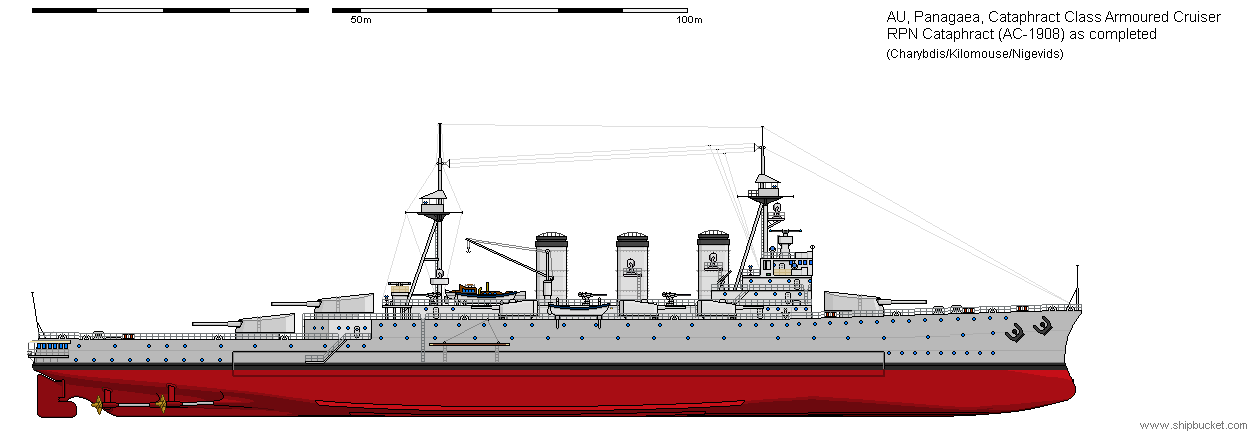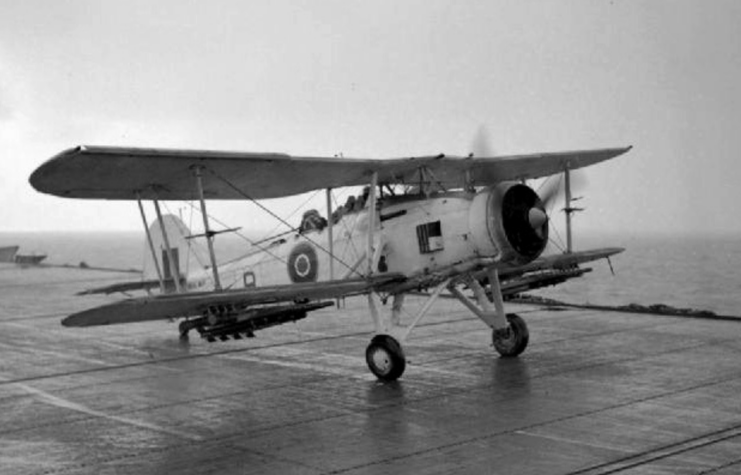Back to Panganaean Navy page
The Cataphract was really the forerunner of the battlecruiser and forced other navies to look at their own designs. The Royal Navy had been made aware of the Cataphract by its own diplomats (spies) who kept an eye on what the Commonwealth Navies were producing. Not all of the innovations came out of Britain or the USA. The Cataphract was to be an advance on the previous Dragoon class, the major advance was adding a third twin 10" turret aft to replace the twin 6" placed there in the Dragoon. To make it somewhat like the semi-dreadnought of the time, six twin 6" turrets became the secondary armament. This kept the ship from becoming too large. The Royal Navy built the Invincible class battlecruisers at a similar time, those ships were considered superior with their 8x12" armament. The following Skirmisher class added another 10" turret for four in total, to combat what the Royal Navy had told the world would be the 9.2" armed Invincible's.

The Cataphract survived the war by being kept in Panagaean waters for all of the war. It was flagship of the Panagaean Coastal Forces and did a lot of work in training duties and a lot of sea time on coastal patrols. Trips around the Pacific carrying the Brass and Politicians, kept the ship busy. Late 1917 and the Panagaean Admiralty learns of the Royal Navies trials with the Furious for landing aeroplanes on and off with wheels. Panagaea would also like to follow these experimental trials with aircraft. Looking round for a suitable ship, the Cataphract was put in the frame for a look. The Cataphract was ten years old but already obsolete. The speed of advance of all the warship classes had passed the Cataphract by. What had happened to the Skirmisher could just as easily have happened to the Cataphract, being included with other ships, like the early battlecruisers, and being totally outclassed. The Admiralty decided the Cataphract would be their trials ship. To that end a flying off platform was fitted forward from the bridge to the bow giving the aircraft enough length to take off into the wind plus the ships forward momentum. Aft the X 10" turret, and aft most 6" turret, were removed and a landing platform fitted from the aft most funnel to the stern of the ship. In this guise the Cataphract proved it was possible for wheeled aircraft to land on and take off from a moving ship.
Having proven the concept the Cataphract was taken in hand for a full conversion, stripping out all of the old weaponry and armour. Utilising whatever bits of equipment could be transferred across. The extra weight of flight deck and hangar plating required the ship to be fitted with bulges. This also gave some protection against underwater damage from mines and/or torpedoes.
The Cataphract joined the fleet in early 1923 and gave valuable experience and training to the new pilots that would be required once the Formidable and Vindictive also joined the fleet a few years later. Once those aircraft carriers had joined, the Cataphract went to its main duties of pilot training and cadet training. The aft part of the hangar could be split off and sectioned for cadets or even short term for the transport of troops to a hotspot. When being used for training the ship would only have half a squadron of bombers and half a squadron of fighters for its own defence. Twice that number would be carried in war time. Fast forward to 1939, and the Cataphract is still in commission and doing what it has for the last 16 years training pilots and cadets. The main change to the armament is the addition of six quad 0.5" machine guns for AA use. Its wartime role does not change from its peace time role - train the future aircrew for the fleet. For another two years the Cataphract stays within Panagaean waters. Then comes Pearl Harbour and suddenly the Pacific is a dangerous place. The Japanese could strike anywhere. Panagaea is almost defenseless, all of its best major warships are in the Atlantic fighting the Germans and Italians. The Cataphract's main role does not change. Being the Training carrier, but now added to that is convoy escort from Panagaea to the United States and Canada. The aircraft aboard ship are six Gloster Griffons and twelve Fairey Swordfish.
June 1942, to stop reinforcements being sent from the US West Coast or Hawaii, while the main fleet attacks Midway, the Japanese set up two lines of submarines to intercept any reinforcements. Targets of major interest would obviously be aircraft carriers. Cataphract is on convoy duty on the route from San Francisco to Resolution. The ship has its Combat air patrol up and three Swordfish are roaming around the convoy hunting for subs. 'Contact', the Cataphract launches two more Swordfish to go to the aid of the aircraft that made contact while a destroyer and frigate are also sent out to the contact. The convoy moves on. One of the Combat Air Patrol calls out 'Torpedoes in the water, running North-west to South-East, turn to North-West to comb the tracks'. The Convoy Commodore orders the change of course. The Cataphract turns with the rest right into one torpedo from the original contact. Of the four submarines in the line, only one is armed with oxygen torpedoes that leave no track, it is one of those that hits the Cataphract. The hit is on the bulge and causes serious damage and lowers the speed to 10 knots while the engineers see what can be done. Which is not much. They can shore up the bulkheads and put a canvas patch across the hole and brace it. Speed is reduced again to 8 knots. Half the escorts are left behind chasing contacts and depth charging anything and everything. The original contact is caught and sunk by the escorts. The convoy carries on to make port at Resolution, the damaged Cataphract goes into dry dock for the damage to be surveyed. The survey shows the hull is warped, the damage is terminal. Thought is given to just sticking a patch over the damage and keeping the ship in home waters only, to carry on the deck landing role. But the damage was also affecting the machinery spaces and that spelled the end of the road for the Cataphract. The ship was parked up against a dock and used as an accommodation ship for two years then it was removed from the Navy list and scrapped. Three months later the first of the Centaur class arrives and assumes the duties that the Cataphract had done.
